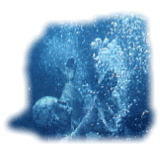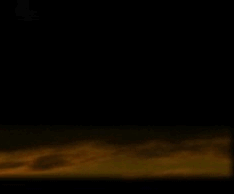|
First uploaded in 1999, I reload the page March 2024 for the 25th anniversary of my website.
Christopher Columbus is the first to have sailed through the Sargasso Sea and the Bermuda Triangle, at least to return and tell about it. He is also the first to have reported unusual events. But no matter how often they are recounted, they are seldom qualified. Ignorance of his logs has reduced these events to vague  rumors, and per usual they are greatly inaccurate. rumors, and per usual they are greatly inaccurate.
But thanks to Oliver Dunne and James Kelley, the extracts from his log which were compiled shortly after his death by Fray Bartolome de Las Casas have been translated (The Diario of Columbus, 1989) and give a vivid picture of many unexpected events.
Columbus, after Sebastiano de Piombo. Painted after the admiral’s death.
Today it is often claimed that on the eve of discovering the New World, Columbus saw a fireball plunge into the sea before his vessels. An “odd forecast” this has been called. Actually, the event happened only a few days after leaving the Canary Islands, long before the Sargasso Sea and the Bermuda Triangle.
However, on the eve of discovering the New World (October 11, 1492) he did actually see a light on the horizon, which does remain unexplained today. In a 1979 documentary based on Charles Berlitz’s popular book The Bermuda Triangle all the elements of cheap tabloid fiction came together to showcase this light as a host of blue-green glowing UFOs. While the flying saucers darted from sea to surface the ship’s compass rocked back and forth. Italian actors with poorly dubbed English lines grunted and moaned. “Capitan, what strange new world have we come to?”
But let’s start at the beginning, and in reality, when Columbus and his 3 caravels Nina, Pinta and Santa Maria were still far out in the ocean.
Thursday 13 September 1492
On this day at the beginning of night the compasses northwested and in the morning they northeasted somewhat.
Monday September 17 1492
The pilots took the north, marking it [North Star], and found that the compasses northwested a full point [11 and one quarter degrees]; and the sailors were fearful and depressed and did not say why. The Admiral was aware of this and he ordered that the north again be marked when dawn came, and they found that the compasses were correct. The cause was that the North Star appears to move and not the compasses.
Sunday 23 September 1492
Since the sea had been calm and smooth the men complained, saying that since in that region there were no rough seas [Sargasso Sea], it would never blow for a return to Spain. But later the sea rose high and without wind, which astonished them, because of which the Admiral says here that the high sea was very necessary for me, a sign which had not appeared except in the time of the Jews when they left Egypt and complained against Moses, who took them out of captivity.
Sunday, 30 September 1492
Also the Admiral says here when night comes the compasses northwest one quarter, and when dawn comes they coincide with the North Star exactly.
Scholarly debate has tried to account for the erratic compass readings. One theory suggests that during the night reading the compass was brought out on deck and set near a bucket of nails or some other metal object which deflected it— though this supposes that the seamen were stupid and did not check for any nearby metal.
Another theory, with less merit, was put forward and remains dominant to this day: that Columbus had merely encountered “magnetic variation,” that is, his compass declined appropriately to remain fixed on Magnetic North. As he was circumnavigating the world in a direction nobody had before, neither he nor the crew would have expected to see the compass decline toward the east.
This unusual explanation even rated its place as the explanation in Hollywood’s 1948 motion picture starring Fredric March as Columbus. To assuage his nervous crew, he explains that ships sailing toward Cathay (China) experience a changing of their compass toward the west, so it seems logical when going toward the west that the compass declines toward the east. In other word, they are trying to give a primitive explanation of compass declination.
It is amazing that this was suggested. It is not possible to detect compass variation with a magnetic compass. After all, the compass always points to Magnetic North. Columbus’ navigator would have noticed nothing in the compass. Magnetic Variation can only be detected with other means today, such as charts, which Columbus obviously did not have. It was when they “took the North” that they realized the compass did not jive with what they expected. Taking the North means waiting till dusk or dawn to detect the North Star (Polaris) and to measure its altitude above the horizon. Its altitude would give them an estimation of their latitude. It was then they noticed a mistake. But this was not magnetic variation or it would not have come and gone nightly as it did.
If it was basic compass declination, it also would have been detected as they sailed the Bahamas and Caribbean, and also on their way back to Spain months later. But it did not. No notation is made in the log that they realized they set the compass near nails or anything. These were transient changes in the magnetism of the area, perhaps hinging on temperature changes of evening and morning which caused the erratic reading at night and the correct one in the morning.
Our compasses are too sophisticated today to be affected by minor changes, but Columbus’ was primitive enough to have registered something disturbing magnetism nearby.
The sea “rising” without any reason might be explained that they encountered the North Equatorial Current while exiting the Sargasso Sea. Without this, it is hard to explain, except as undersea tremors.
On the eve of discovery, there was that unknown event already mentioned. A light was seen in the distance; it rose and dropped and then disappeared. Some try to explain this as torch lights on the beach of an island or that native fishing parties with torches were some miles off the island. Columbus landfall scholars have puzzled this light. It has been used to calculate his distance from any land. But it usually turns out, by varied calculations today, that he was too far to have seen any light on land— hence it must be fishermen at sea trying to get their evening catch. Scholars note that Columbus never discovered the sources after landing on San Salvador. In modern vernacular, perhaps, Columbus would have eventually opted to have called it a “weird light” as many others in the Bahamas have done with more modern sightings of the same.
All of this did happen in the Triangle. These incidents have never been explained and remain odd forecasts before the discovery of the New World and of the unusual events still being seen in the Bermuda Triangle.
|


